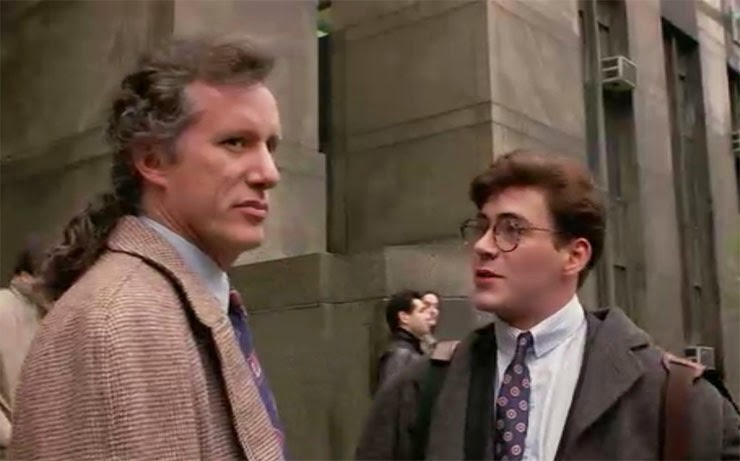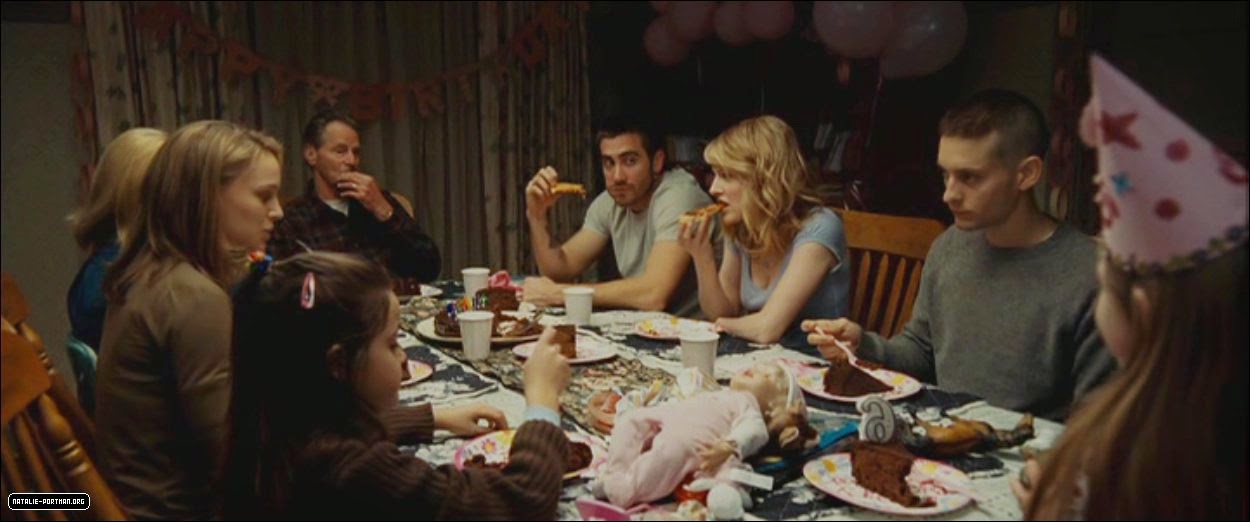The
1980s was a great decade for fans of James Woods as it featured some of his
most memorable performances in a diverse collection of films like Videodrome (1983), Once Upon a Time in America (1984), Salvador (1986), Best Seller
(1987), and Cop (1988). The actor
rounded out the decade with a riveting turn as a crusading lawyer in True Believer (1989). Based loosely on a
series of investigative articles by Pulitzer Prize-nominated journalist K.W. Lee, Woods plays a burnt-out attorney who teams up with an idealistic legal
clerk, played by a young Robert Downey Jr., to free a man in prison for a crime
he didn’t commit.
The
film starts off by rubbing your face in the harsh realities of prison life as a
young Asian man by the name of Shu Kai Kim (Yuji Okumoto) fights for his life
against a white supremacist. And then, bang—we’re in New York City as young
legal clerk Roger Baron (Downey) arrives fresh off the train with a bevy of
suitcases as he tracks down legendary lawyer Edward J. Dodd (Woods) in some
anonymous courtroom delivering a fiery speech railing against the police’s
illegal surveillance methods on his client – a white collar drug dealer. In a
nice touch, his client leaves the courthouse in a Porsche driven by his wife.
The
initial courtroom scene is a fantastic introduction to Dodd as Woods gets to
deliver a passionate speech as only he can. Roger gushes about Dodd’s past
triumphs as they make their way to his Greenwich Village office. Seeing his
hero defend mid-level drug dealers is a jarring experience for Roger who has to
quickly adapt to his surroundings and adjust his expectations accordingly.
One
night, an elderly Korean woman and her neighbor show up asking Dodd for help.
The woman’s son – Kim from the opening scene – was sent to prison for eight
years for a killing a man in an apparent gang initiation. They claim he’s
innocent, but to make matters worse, he killed a man in prison. Dodd is polite
to the two women, but his caseload is full and Kim isn’t a drug dealer.
However, Roger is moved by the mother’s story and pushes Dodd to take the case.
Dodd
has been lost in clouds of pot smoke and coasting on a steady caseload of drug
dealers. He’s lost touch with the idealism and beliefs that were so strongly
instilled in him during the 1960s, but were gradually eroded away until he
became a cynical opportunist deluding himself into thinking he’s still making a
difference. Roger awakens the ideals Dodd had buried deep inside for years.
Dodd
decides to take the case and the deeper that he and Roger dig, the more complex
they find it as the two men wade through hate groups and police corruption.
Their investigation takes them through the gritty underbelly of the city as
they uncover dirty secrets that the powers that be tried to bury. I like that
director Joseph Ruben shows Dodd and Roger doing grunt work, like spending a
night going through files to find something they can use in their case. They
pound the pavement and talk to witnesses who might have seen something back
then. Ruben also does a nice job of showing how Dodd lives in the shadow of the
‘60s in a scene where the lawyer leaves a bar while “Crystal Ship” by The Doors
plays quietly in the background and then gradually gets louder as he walks the
streets of the city.
Actors
love lawyer roles because it gives them an opportunity to deliver dramatic
speeches and work the courtroom like they’re on stage and in a way they are.
James Woods is a top-notch actor and this kind of juicy role is something he
can really sink his teeth into with gusto. It’s great to see him play a
character full of righteous anger. He also gets to face off against a hardnosed
opponent – in this case, Robert Reynard, a tough district attorney played by
Kurtwood Smith with his usual no-nonsense style. Ever the committed actor,
Woods puts it all out there and it’s hard not to root for Dodd to succeed
against insurmountable odds. He’s such an interesting actor to watch in the
choices he makes in a given scene to how he conveys the dramatic arc of his
character over the course of the film.
Robert
Downey, Jr. is good as a wet-behind-the-ears associate whose book smarts is the
yin to Dodd’s street smarts yang. He’s eager and idealistic without overdoing
it to the point of being annoying about it. Roger’s job is to reawaken the
passion in Dodd that has lain dormant for years. There is an interesting visual
contrast between the clean-cut Roger and the rumpled-looking Dodd that
complements their different personalities. They are an odd couple to be sure,
but they are united by the same goal: to correct an injustice.
Kurtwood
Smith has made a career of playing smug pricks (see Robocop and Flashpoint)
and his D.A. is an overconfident man that thinks he’ll crush Dodd in the
courtroom. It is these traits that make you want to see Dodd win his case even
more and destroy Reynard in the courtroom. It’s great to see Smith strut his
stuff as he delivers a dramatic opening argument and then goes on to trade
verbal body blows with Woods as they uses witnesses to convince the jury that
they are right. It is an excellent battle of wills that is fascinating to
watch.
Director
Joseph Ruben was drawn to True Believer
because it was “a good, strong mystery, which I love. I like the characters a
lot. I like the New York world, the underbelly.” The character of Edward J.
Dodd was partly modeled on real-life San Francisco area attorney J. Tony Serra
whose high acquittal rate was the stuff of legend in the legal world. Ruben
butted heads with Woods during pre-production over the wig that the actor would
wear to play the longhaired Dodd. Woods flip-flopped several times over whether
he would wear it or not. Ruben and the producers got so frustrated that they
seriously considered quitting the project. He got Serra and Woods to meet over
dinner. They got along famously and Woods finally agreed to don the wig.
Ruben
said of working with Woods, “The one thing with Jimmy is he is so strong an
actor and he attacks a scene so much that you can’t give him raw direction …
You’ve got to be pretty precise with him.” In contrast, Robert Downey showed up
with all kinds of ideas as Ruben remembered: “He came in the first day of
rehearsal with an interesting haircut and these punk glasses unlike anything
you’ve ever seen. And I thought, that’s exactly it, that’s exactly the
character.”
True Believer received mostly positive
reviews. Roger Ebert gave the film three out of four stars and wrote, “Woods
makes movies in which the audience has to be on its toes to keep up with him.
It’s quite an act, and when I see Woods on the screen in the first shot of a
movie I sort of smile to myself because I know that something strange and
offbeat and maybe even inspired is about to happen.” In her review for The New York Times, Janet Maslin praised
Ruben’s direction and working with “a story that doesn’t wear thin once its
premise has been established. He also has a more mobile and exciting camera
style this time, and his direction remains lively and surprising to the end.”
The Chicago Tribune’s Dave Kehr wrote,
“Most remarkable, though, is Ruben’s refusal to treat Eddie’s moral
regeneration as a simple narrative convention; where most directors of the
moment would treat it only as the easiest way of getting from point A to point
B, for Ruben it is something solid and real, to be presented with care and
conviction.”
However,
the Los Angeles Times’ Sheila Benson
wrote, “Dodd is another in James Woods’ dizzying catalogue of interchangeable
characterizations in which only his hairdos vary.” In his review for the Washington Post, Hal Hinson wrote, “Part
of the problem is that Ruben relies too heavily on Woods’ whirring turbines to
power his scenes. The fault here lies more in the material than in Ruben’s
handling of it. There’s an attraction to the dilemma of a ‘60s provocateur
stranded in the moral gray zone of the ‘80s, but the themes aren’t well served
by the thriller plot.” When asked, a few years later, why True Believer failed commercially, Ruben said, “I think the title
was a hard sell. Also it wasn’t easy to get the idea right off the bat.”
True Believer is as much a story about
finding the truth as it is about Dodd’s redemption. At times, it looks and
feels like it could exist in the same world as Sidney Lumet’s police corruption
films. Woods and Downey make for a good team, playing well off each other, but
let’s face it, this is Woods’ show. In the ‘80s, he was given the opportunity
to headline several films playing flawed protagonists. True Believer is no different as he plays a ‘60s crusader worn down
by the system over the years, but finds that passion again thanks to a young
upstart that reminds him of what he used to be.
SOURCES
Hoban,
Phoebe. “Hollywood’s Newest Golden Boy.” Premiere. 1989.
Lantos,
Jeffrey. “Director Joe Ruben on Julia Roberts, Dastardly Extras and Surviving
the Pom-Pom Girls.” Movieline.
February 1, 1991.
Rea,
Steven. “Ruben’s Redemption.” Philadelphia Inquirer. February 26, 1989.
Strauss,
Bob. “Can You Believe He’s Calming Down?” Los Angeles Daily News. March
5, 1989.





















